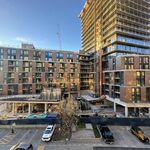unimaginative2
Senior Member
Council backs plan to put cycling in the fast lane
JOHN BARBER
jbarber@globeandmail.com
January 30, 2008
Once upon a time Toronto was well known as a good city for cyclists, and not just because it's flat. Mayor John Sewell demonstrated just how cycle-friendly the central city could be by going everywhere on two wheels 30 years ago. While other cities built recreational trails, Toronto pioneered the promotion of cycling as a viable mode of urban transportation.
As other cities struggled to catch up, the plaudits rolled into Toronto.
Then, suddenly, it all stopped. Amalgamation swept such quaint activities aside while empowering a new set of suburban politicians who, if they cared about it at all, were openly hostile toward cycling. While other cities laid on bike lanes in response to public demand, Toronto politicians snorted about alleged frills and feared inconvenience to drivers. Innovation moved elsewhere.
The city still has a cycling committee, and a budget, not to mention the usual award-winning plan. What Toronto lacks is the infrastructure other cities built while it dozed.
Today Councillor Adrian Heaps, new chair of the cycling committee, will promote winter cycling by leading a "Coldest Day of the Year Ride" downtown - just the sort of frontier activity Toronto once loved to encourage. But this time we're just catching up. Comparably frigid Ottawa and Montreal both have far more dedicated winter riders than Toronto.
The problem today is not lack of good intentions. Like so much else in the megacity, the bicycling failure is an operational issue. The money for more lanes is there, but every year it goes unspent. For years now the city has been unable to build even the minimum number of new bike lanes its own plans and budgets call for. Of the approximately 500 kilometres of new bicycle lanes that are supposed to be built by 2010, fewer than 100 have appeared.
Behind the scenes, the bureaucrats blame individual politicians and cumbersome processes for the failure. But they seem all too willing to live with the blockages. The increasingly large cycling committee planned well, protested much and accomplished little.
As of this week, though, that stands to change. Perhaps it needed a suburbanite to do it - an outsider unaffected by the old stalemate - but the Scarborough cyclist has quietly instituted two reforms that could easily double the number of new bike lanes the city builds every year.
Mr. Heaps's first smart move was to cut the membership of the sprawling committee by about two-thirds. More importantly, council quietly approved his proposal to reassert control over the lane-approval process yesterday, making it impossible for individual politicians to deny approvals at community council.
That change alone should help Toronto build as much as 50 kilometres of new bike lanes in 2008, according to Mr. Heaps, compared with seven or eight kilometres a year currently.
If individual politicians still complain about having bike lanes traverse the ward, Mr. Heaps won't waste time twisting arms. Rather than letting one pocket of resistance forestall entire new routes, he plans to build what he can, following what he calls "the path of least resistance."
There wasn't a word of protest when the last element of the new plan fell into place at council yesterday afternoon, which could be the most promising sign of all. With Markham, Mississauga and Calgary now routinely embarrassing us in such matters, even redneck Toronto is changing its colours.
==========================================================
The biggest problem is that Toronto's bicycle paths, while relatively abundant, aren't very useful. The narrow little painted lanes on the road that routinely get obstructed by parked cars hardly do much to make cycling more pleasant. Toronto needs real bike routes like in Montreal or Europe, with a two-lane bike mini-roadway separated by a curb from the road and the sidewalk. It takes up the same amount of road width, but it's far, far safer.
JOHN BARBER
jbarber@globeandmail.com
January 30, 2008
Once upon a time Toronto was well known as a good city for cyclists, and not just because it's flat. Mayor John Sewell demonstrated just how cycle-friendly the central city could be by going everywhere on two wheels 30 years ago. While other cities built recreational trails, Toronto pioneered the promotion of cycling as a viable mode of urban transportation.
As other cities struggled to catch up, the plaudits rolled into Toronto.
Then, suddenly, it all stopped. Amalgamation swept such quaint activities aside while empowering a new set of suburban politicians who, if they cared about it at all, were openly hostile toward cycling. While other cities laid on bike lanes in response to public demand, Toronto politicians snorted about alleged frills and feared inconvenience to drivers. Innovation moved elsewhere.
The city still has a cycling committee, and a budget, not to mention the usual award-winning plan. What Toronto lacks is the infrastructure other cities built while it dozed.
Today Councillor Adrian Heaps, new chair of the cycling committee, will promote winter cycling by leading a "Coldest Day of the Year Ride" downtown - just the sort of frontier activity Toronto once loved to encourage. But this time we're just catching up. Comparably frigid Ottawa and Montreal both have far more dedicated winter riders than Toronto.
The problem today is not lack of good intentions. Like so much else in the megacity, the bicycling failure is an operational issue. The money for more lanes is there, but every year it goes unspent. For years now the city has been unable to build even the minimum number of new bike lanes its own plans and budgets call for. Of the approximately 500 kilometres of new bicycle lanes that are supposed to be built by 2010, fewer than 100 have appeared.
Behind the scenes, the bureaucrats blame individual politicians and cumbersome processes for the failure. But they seem all too willing to live with the blockages. The increasingly large cycling committee planned well, protested much and accomplished little.
As of this week, though, that stands to change. Perhaps it needed a suburbanite to do it - an outsider unaffected by the old stalemate - but the Scarborough cyclist has quietly instituted two reforms that could easily double the number of new bike lanes the city builds every year.
Mr. Heaps's first smart move was to cut the membership of the sprawling committee by about two-thirds. More importantly, council quietly approved his proposal to reassert control over the lane-approval process yesterday, making it impossible for individual politicians to deny approvals at community council.
That change alone should help Toronto build as much as 50 kilometres of new bike lanes in 2008, according to Mr. Heaps, compared with seven or eight kilometres a year currently.
If individual politicians still complain about having bike lanes traverse the ward, Mr. Heaps won't waste time twisting arms. Rather than letting one pocket of resistance forestall entire new routes, he plans to build what he can, following what he calls "the path of least resistance."
There wasn't a word of protest when the last element of the new plan fell into place at council yesterday afternoon, which could be the most promising sign of all. With Markham, Mississauga and Calgary now routinely embarrassing us in such matters, even redneck Toronto is changing its colours.
==========================================================
The biggest problem is that Toronto's bicycle paths, while relatively abundant, aren't very useful. The narrow little painted lanes on the road that routinely get obstructed by parked cars hardly do much to make cycling more pleasant. Toronto needs real bike routes like in Montreal or Europe, with a two-lane bike mini-roadway separated by a curb from the road and the sidewalk. It takes up the same amount of road width, but it's far, far safer.




